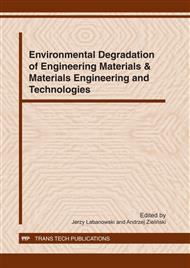p.117
p.125
p.131
p.137
p.143
p.149
p.155
p.163
p.169
Electrochemical Properties of Ni-Cr and Co-Cr Alloys Used in Prosthodontics
Abstract:
The aim of the work was evaluation of electrochemical properties of Co-based alloys (Remanium GM 800+ and Biosil F) and Ni-based alloys (Heraenium NA and Remanium G-Soft) commonly used on frameworks for porcelain faced cast partial dentures. First stage of the work was evaluation of surface roughness by means of direct linear contact measurement (SURTRONIC 3+ profiler, Taylor/Hobson) of samples after casting and surface treatment. Electrochemical properties of surface were assessed by means of potentiodynamic and impedance methods. In potentiodynamic tests, in order to evaluate pitting corrosion resistance of the analyzed alloys, anodic polarization curves were recorded. The VoltaLab® PGP 201 system was applied in corrosion tests. Moreover, in order to evaluate structure and properties of the surface layer the electrochemical impedance spectroscopy (EIS) was applied. Selection of this method enabled to determine the impedance of the material – surface layer – solution interface with the use of approximation of impedance data by means of equivalent electric circuit model. The EIS tests were carried out with the use of the AutoLab PGSTAT 302N system equipped with the FRA2 Faraday impedance module. Electrochemical tests were carried out in artificial saliva at the temperature of 37°C and pH = 7,0±0,1.
Info:
Periodical:
Pages:
143-148
Citation:
Online since:
December 2011
Authors:
Keywords:
Price:
Сopyright:
© 2012 Trans Tech Publications Ltd. All Rights Reserved
Share:
Citation:


